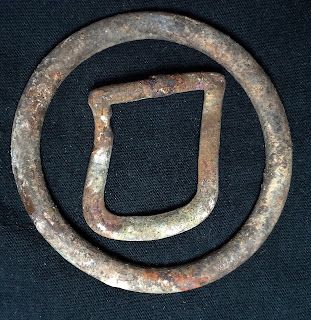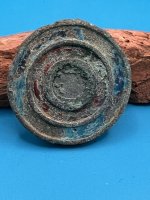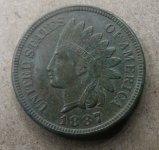scaupus
Hero Member
George E. Merrick Farm Artifacts Discovered on Coral Gables Pioneer Day
Learning about the real history of a place is no game for wussies. Sometimes you have to defy the established order and just dig where you know you must, then let the results speak for themselves.
Last weekend I did just that. In one of those strange coincidences, I was digging up relics from the homestead of Coral Gables' foremost pioneer and founder, George E. Merrick, on the same day that the city of Coral Gables was celebrating Pioneer Day. I had no idea Coral Gables even had a pioneer day, but I think it's a good idea.
George moved down to Miami in 1899 as a teenager with his father from Massachusetts by way of Pennsylvania. They quickly improved the impoverished Dade County homestead that they had bought sight unseen, and with the advise and help of their black Bahamian neighbors they quickly became successful truck farmers. (Merrick gave the Bahamians credit for informing the American settlers how to grow tropical plants on limestone rock in an article he wrote for the Historical Society of South Florida in the 1940s just before he died.) As a young man, George Merrick often drove a mule and wagon loaded with vegetables over to the Royal Palm Hotel at the mouth of the Miami River. Anything the hotel did not buy, he peddled around town. After a few years growing vegetables for sale in Miami, the citrus and avocado groves that George and his father had planted started bearing fruit. By 1913, Coral Gables Plantation, as the Merricks had named their farm, was the largest agricultural operation in South Florida, with a packing plant on-site.
But farming was no longer the foremost activity in South Florida for ambition men: urban real estate development was the new ticket to success. Merrick was already a wealthy real estate agent and subdivision developer in Miami by 1921 when he determined to design and build a new city from scratch, several miles southwest of Miami, out in what was then the boonies. At the heart of Merrick's planned city would be his own family farm of 160 acres. He bought a vast quantity of acreage in addition to the original homestead, and he began sub-dividing his farm and groves and the virgin Dade County pine forests into city lots with broad boulevards, grand plazas, elegant Mediterranean style structures, the world famous Venetian pool, electrified lighting, sidewalks, even a new university. It was his intention to create the most beautiful, well conceived and executed new city that the 20th century could produce. To a certain extent, he succeeded. In any case, the family farm ceased to exist, and in 1925 the city of Coral Gables was officially incorporated.
The family farm is indeed long gone, but the Merrick family home still stands in the city of Coral Gables. Today it is a museum, owned by the city, open to the public, and is preserved very much as it was in the 1920's. It sits on a city lot about half an acre in size, just a tiny remnant of the original homestead. It is shaded by massive, old live oaks.
Well, it occurred to me that artifacts from the old Merrick homestead could still be buried under present day Coral Gables. It would be a gas to find something connected to Merrick. But how to get access to the most likely spots to dig?
Of course, digging is not permitted on the museum property itself. But it is permitted on the public right-of-ways that now transect the old Merrick farm. The house today faces Coral Way, which runs along the southern boundary of the museum property. Castile Avenue borders the rear of the property, and its 7' wide, bare dirt swale runs contiguous to the museum's property line for about 60 yards, and it's only 40 yards from the back door of the main house. This strip of earth would have been an intimate part of the Merrick farmstead prior to the subdividing of the Merrick farm ca.1921.
I used my White's Eagle Spectrum metal detector to sweep the swale from one end of the property to the other. I only found two artifacts, but they are humdingers, and announce clearly that on this site horses and/or mules had been used as draft animals. I recovered a brass harness ring and buckle. I found them within a few inches of each other in a single hole, about 7" deep. As I first handled these artifacts, it was easy to imagine the young George E. Merrick using these very items to harness his mule to the wagon full of vegetables, bound for market in Miami at the crack of dawn.
The significance of these artifacts lies mainly in their connection to George Merrick. I don't think it would be a stretch to say he is to Coral Gables what George Washington is to the Unites States. These artifacts do also tend to confirm that on this site there had been a working farm, a point not in dispute, nonetheless, these are real, physical artifacts attesting to that fact.
At some point, the farmstead structures were torn down, the contents were sold, the old worn harness was discarded, the leather or fibers rotted away, the brass sank into the soil, the ground was filled and leveled, the street paved, and the old brass harness tack was buried away in the darkness under ground for a hundred years.
 Brass harness ring and buckle
Brass harness ring and buckle
Click on the picture to see the video:
Unfortunately for Merrick, the hurricane of 1926 killed the real estate craze in South Florida. The bubble burst, and reputable developers like Merrick went bust along with many of the frenzied speculators flipping properties. Merrick lost everything but the family home. He did secure a position as postmaster of Coral Gables, however, a job he held at the time of his death in 1942.
Learning about the real history of a place is no game for wussies. Sometimes you have to defy the established order and just dig where you know you must, then let the results speak for themselves.
Last weekend I did just that. In one of those strange coincidences, I was digging up relics from the homestead of Coral Gables' foremost pioneer and founder, George E. Merrick, on the same day that the city of Coral Gables was celebrating Pioneer Day. I had no idea Coral Gables even had a pioneer day, but I think it's a good idea.
George moved down to Miami in 1899 as a teenager with his father from Massachusetts by way of Pennsylvania. They quickly improved the impoverished Dade County homestead that they had bought sight unseen, and with the advise and help of their black Bahamian neighbors they quickly became successful truck farmers. (Merrick gave the Bahamians credit for informing the American settlers how to grow tropical plants on limestone rock in an article he wrote for the Historical Society of South Florida in the 1940s just before he died.) As a young man, George Merrick often drove a mule and wagon loaded with vegetables over to the Royal Palm Hotel at the mouth of the Miami River. Anything the hotel did not buy, he peddled around town. After a few years growing vegetables for sale in Miami, the citrus and avocado groves that George and his father had planted started bearing fruit. By 1913, Coral Gables Plantation, as the Merricks had named their farm, was the largest agricultural operation in South Florida, with a packing plant on-site.
But farming was no longer the foremost activity in South Florida for ambition men: urban real estate development was the new ticket to success. Merrick was already a wealthy real estate agent and subdivision developer in Miami by 1921 when he determined to design and build a new city from scratch, several miles southwest of Miami, out in what was then the boonies. At the heart of Merrick's planned city would be his own family farm of 160 acres. He bought a vast quantity of acreage in addition to the original homestead, and he began sub-dividing his farm and groves and the virgin Dade County pine forests into city lots with broad boulevards, grand plazas, elegant Mediterranean style structures, the world famous Venetian pool, electrified lighting, sidewalks, even a new university. It was his intention to create the most beautiful, well conceived and executed new city that the 20th century could produce. To a certain extent, he succeeded. In any case, the family farm ceased to exist, and in 1925 the city of Coral Gables was officially incorporated.
The family farm is indeed long gone, but the Merrick family home still stands in the city of Coral Gables. Today it is a museum, owned by the city, open to the public, and is preserved very much as it was in the 1920's. It sits on a city lot about half an acre in size, just a tiny remnant of the original homestead. It is shaded by massive, old live oaks.
Well, it occurred to me that artifacts from the old Merrick homestead could still be buried under present day Coral Gables. It would be a gas to find something connected to Merrick. But how to get access to the most likely spots to dig?
Of course, digging is not permitted on the museum property itself. But it is permitted on the public right-of-ways that now transect the old Merrick farm. The house today faces Coral Way, which runs along the southern boundary of the museum property. Castile Avenue borders the rear of the property, and its 7' wide, bare dirt swale runs contiguous to the museum's property line for about 60 yards, and it's only 40 yards from the back door of the main house. This strip of earth would have been an intimate part of the Merrick farmstead prior to the subdividing of the Merrick farm ca.1921.
I used my White's Eagle Spectrum metal detector to sweep the swale from one end of the property to the other. I only found two artifacts, but they are humdingers, and announce clearly that on this site horses and/or mules had been used as draft animals. I recovered a brass harness ring and buckle. I found them within a few inches of each other in a single hole, about 7" deep. As I first handled these artifacts, it was easy to imagine the young George E. Merrick using these very items to harness his mule to the wagon full of vegetables, bound for market in Miami at the crack of dawn.
The significance of these artifacts lies mainly in their connection to George Merrick. I don't think it would be a stretch to say he is to Coral Gables what George Washington is to the Unites States. These artifacts do also tend to confirm that on this site there had been a working farm, a point not in dispute, nonetheless, these are real, physical artifacts attesting to that fact.
At some point, the farmstead structures were torn down, the contents were sold, the old worn harness was discarded, the leather or fibers rotted away, the brass sank into the soil, the ground was filled and leveled, the street paved, and the old brass harness tack was buried away in the darkness under ground for a hundred years.

Click on the picture to see the video:
Unfortunately for Merrick, the hurricane of 1926 killed the real estate craze in South Florida. The bubble burst, and reputable developers like Merrick went bust along with many of the frenzied speculators flipping properties. Merrick lost everything but the family home. He did secure a position as postmaster of Coral Gables, however, a job he held at the time of his death in 1942.
Last edited:
Upvote
3







